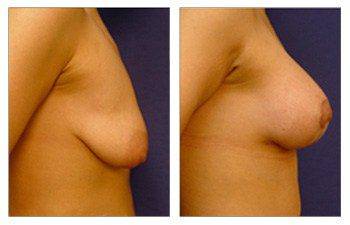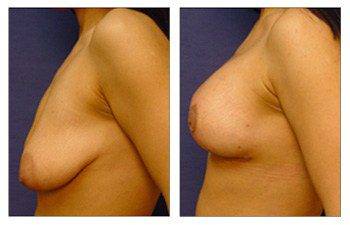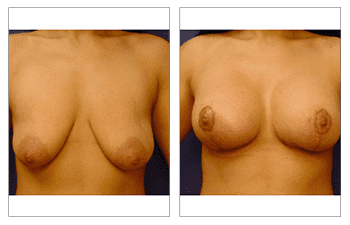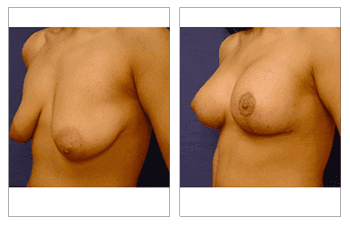





Breast lift with the implant to correct breast sagging is the most common reason for breast lift surgery. Unfortunately, the natural aging process results in a decrease in skin elasticity. This is due to a decrease in the body’s production of the elastin protein which is primarily responsible for our skin’s ability to stretch and recoil back into place. Without this protein, we begin to see sagging skin like our patients here. Through the use of breast implants, you are less limited in your ideal breast size and shape. Not only did this patient want to eliminate her saggy skin, but she also wanted fuller breasts as well which resulted in the need for a breast lift with the implant to correct breast sagging.
A breast lift with implant surgery is a very common plastic surgery procedure. As such, it has been studied extensively and can be performed in various ways. The absolute gold standard in breast lift surgery is the vertical mastopexy technique. While this does result in the “anchor” incision line, there is no substitute for the harmonious and beautiful shape and size it can achieve.
Introduction: Breast Lift with Implants to Correct Breast Sagging
The female breast has long been celebrated as a symbol of femininity, beauty, and sensuality. However, as time, age, and various life events take their toll, many women experience breast sagging, which can have a significant impact on their self-esteem and body image. To address this issue, breast lift with implants, also known as mastopexy with augmentation, has emerged as a popular and effective solution. In this essay, we will explore the procedure, its benefits, considerations, and potential risks, offering a comprehensive overview of breast lift with implants as a means to restore confidence and youthfulness for women facing breast sagging.
I. Understanding Breast Sagging
Breast sagging, medically known as ptosis, is a common concern for women. It occurs due to a combination of factors, including age, pregnancy, breastfeeding, genetics, and weight fluctuations. Ptosis manifests as a downward descent of the breast tissue and can lead to a loss of volume and firmness. The severity of sagging is often categorized into three grades:
- Mild Ptosis: The nipple is at or above the inframammary fold (the crease beneath the breast), but the lower breast tissue sags slightly.
- Moderate Ptosis: The nipple is positioned below the inframammary fold and a more significant portion of the breast tissue sags.
- Severe Ptosis: The nipple is significantly below the inframammary fold and a substantial amount of breast tissue droops.
Breast sagging can have both physical and psychological effects on women, leading to discomfort, self-consciousness, and a negative impact on their self-esteem.
II. The Breast Lift with Implant Procedure
A. Initial Consultation
The journey to restoring youthful, perky breasts often begins with an initial consultation with a board-certified plastic surgeon. During this consultation, the surgeon evaluates the patient’s breast anatomy, skin quality, and the degree of sagging. The patient’s aesthetic goals and medical history are also discussed, helping to determine the most appropriate surgical plan.
B. Preoperative Preparations
Before undergoing a breast lift with implants, patients are advised to follow certain preoperative preparations. These may include ceasing smoking and certain medications, as well as maintaining a healthy lifestyle to optimize the body’s healing ability.
C. Anesthesia and Incision Placement
The surgical procedure begins with the administration of anesthesia, usually either general anesthesia or intravenous sedation. The choice of anesthesia depends on the surgeon’s recommendations and the patient’s preference.
Incision placement is a crucial decision in the breast lift with implant surgery, as it determines the extent of scarring and the level of lift achieved. Common incision options include:
- Periareolar Incision: Made around the areola, this incision is well-concealed but is suitable for moderate to mild breast sagging.
- Vertical Incision (Lollipop Incision): This incision runs around the areola and vertically down to the inframammary fold, allowing for more significant lifting.
- Anchor Incision (Inverted-T or Wise Pattern): This incision includes a horizontal incision along the inframammary fold, making it ideal for correcting severe breast sagging.
D. Reshaping the Breast Tissue
After the incisions are made, the surgeon reshapes the breast tissue and removes excess skin, providing a lifted appearance. This is a crucial step in achieving the desired breast shape.
E. Implant Placement
Implants, typically silicone or saline, are placed to augment the breast size and restore volume lost due to sagging. The choice of implant type and size depends on the patient’s goals and the surgeon’s recommendations.
F. Closing Incisions
Once the breast tissue has been reshaped and the implants are in place, the surgeon closes the incisions meticulously, using sutures or skin adhesives to minimize scarring.
III. Benefits of Breast Lift with Implants
A. Enhanced Breast Appearance
The primary benefit of a breast lift with implants is the restoration of a more youthful and aesthetically pleasing breast appearance. The combination of lifting the sagging breast tissue and adding volume with implants creates a fuller, firmer, and more attractive breast shape.
B. Improved Self-Esteem
Many women who undergo this procedure report a significant boost in self-esteem and body confidence. The transformation in their breast appearance often extends to a positive impact on their overall self-image.
C. Customizable Results
The surgery is highly customizable, allowing patients to achieve their desired breast shape and size. Surgeons work closely with patients to understand their aesthetic goals and tailor the procedure to meet those expectations.
D. Long-Lasting Results
Breast lift with implants provide long-lasting results. While the effects of aging and gravity may eventually lead to some natural sagging, the procedure can significantly delay this process, allowing patients to enjoy their rejuvenated breasts for many years.
E. Recovery Period
Recovery after breast lift with implants typically involves some discomfort, swelling, and bruising. Patients are usually advised to take time off work and avoid strenuous physical activities for a few weeks. Proper postoperative care and follow-up with the surgeon are essential for a smooth recovery with and without clothes.
If you are having trouble with saggy boobs, consider a complimentary consultation with a plastic surgeon to see if a breast lift with the implant can correct your breast sagging.
Here is a 26-year-old female 1 month following simultaneous breast lift and breast augmentation with 325cc saline implants. Her incision lines will continue to heal and will be nearly invisible by the 3-6 month mark.
